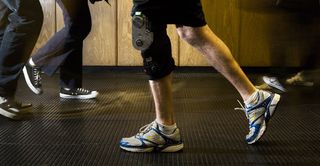Charge Your Cell Phone Just By Walking

Charging your cell phone might soon be as simple as taking a walk around the block.
Scientists have created a new machine that harvests energy from the movement of the knees while walking.
Six volunteers wore the devices on their legs while strolling on a treadmill and were able to produce about five watts of electrical power each. That's enough energy to run 10 cell phones simultaneously.
"Since muscles are the powerhouses of the body, my colleagues and I designed our device to generate electricity from the motion of the knee joint," said Max Donelan, director of the Locomotion Laboratory at Simon Fraser University in Canada. "It resembles a knee brace and weighs about 1.5 kilograms [3.3 pounds] including the gearing and generator."
Results from tests of the device were published in the Feb. 8 issue of the journal, Science.
The apparatus captures the energy of a person's movement by coupling an electrical generator to knee motion.
When the wearer extends the knee, a gear on the device turns and spins the generator, which builds up energy.
Sign up for the Live Science daily newsletter now
Get the world’s most fascinating discoveries delivered straight to your inbox.
When the knee is flexed, the device turns off so as not to tax the wearer. The machine senses motion and knows when to activate itself.
The design allows a person to use the tool without expending much additional energy beyond the normal demands of walking. The researchers measured the volunteers' oxygen intake and carbon-dioxide output to make sure it wasn't strenuous to use.
Work on a similar device built into a backpack was announced in 2005.
“People are an excellent source of portable power," Donelan said. "An average-sized person stores as much energy in fat as a 1,000-kilogram battery. People recharge their body batteries with food and, lucky for us, there is about as much useful energy in a 35-gram granola bar as in a 3.5-kilogram lithium-ion battery.”
The device could be used to power computers in remote regions where electricity is scarce, Donelan said.
"The early markets are people whose lives depend on portable power, such as people with artificial limbs," Donelan told LiveScience. "On the military side, soldiers have an incredible dependence on batteries these days, so both these groups could benefit."
- Video: Scientists Develop Bionic Arm
- 10 Technologies That Will Transform Your Life
- Power of Pee Runs a Battery
Most Popular



